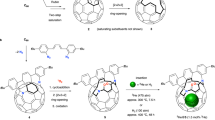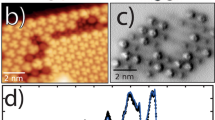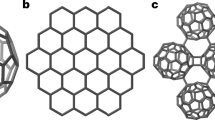Abstract
WHEN fullerenes1,2 are fragmented by laser irradiation, they lose C2 fragments and retain a closed carbon cage3. The detailed mechanism of this process remains unknown, although survival of the cage implies that annealing (rearrangement of the bonding) must play an important role3,4. Here we use ab initio quantum-chemical calculations to show that fullerene annealing happens more readily than fragmentation, and that both are intimately related. Our findings imply that the assumptions commonly made about fullerenes5—that they are composed of five- and six-membered rings of sp2 carbons— are not valid under high-energy conditions. In particular, the appearance of sp3 carbon and seven-membered rings is central in both the annealing and fragmentation processes. Our theoretical predictions imply that the high-energy processes of fullerene growth6–11 and coalescence12 are much richer than previously thought, and that their mechanisms may also involve structures containing sp3 carbon and seven-membered rings. Our results may aid in the design of experimental methods for controlling the nature of fullerene cages (for example, doping, opening and re-closing them).
This is a preview of subscription content, access via your institution
Access options
Subscribe to this journal
Receive 51 print issues and online access
$199.00 per year
only $3.90 per issue
Buy this article
- Purchase on Springer Link
- Instant access to full article PDF
Prices may be subject to local taxes which are calculated during checkout
Similar content being viewed by others
References
Kroto, H. W., Heath, J. R., O'Brien, S. C., Curl, R. F. & Smalley, R. E. Nature 318, 162–163 (1985).
Krätschmer, W., Lamb, L. D., Fostiropoulos, K. & Huffman, D. R. Nature 347, 354–358 (1990).
O'Brien, S. C., Heath, J. R., Curl, R. F. & Smalley, R. E. J. chem. Phys. 88, 220–230 (1988).
Curl, R. F. Phil. Trans. R. Soc. A343, 19–32 (1993).
Kroto, H. W. Nature 329, 529–531 (1987).
Kroto, H. W. & McKay, K. Nature 331, 328–331 (1988).
Smalley, R. E. Acct. Chem. Res. 25, 98–105 (1992).
Heath, J. R. in Fullerenes: Synthesis, Properties, and Chemistry of Large Carbon Clusters (eds Hammond, G. S. & Kuck, V. J.) 1–27 (Am. chem. Soc. Symp. Ser. No. 481, Washington DC, 1991).
Helden, G. V., Gotts, N. G. & Bowers, M. T. Nature 363, 60–63 (1993).
Hunter, J., Fye, J. & Jarrold, M. F. Science 260, 784–786 (1993).
McElvany, S. W., Ross, M. M., Goroff, N. S. & Diederich, F. Science 259, 1594–1596 (1993).
Yeretzian, C., Hansen, K., Diederich, F. & Whetten, R. L. Nature 359, 44–47 (1992).
Dewar, M. S. & Thiel, W. J. Am. chem. Soc. 99, 4907–4917 (1977).
Almlöf, J., Faegri, K. Jr & Korsell, K. J. comput. Chem. 3, 385–399 (1982).
Ahlrichs, R., Bär, M., Häser, M., Horn, H. & Kölmel, C. Chem. Phys. Lett. 162, 165–169 (1989).
Parr, R. G. & Yang, W. Density-Functional Theory of Atoms and Molecules (Oxford Univ. Press, New York, 1989).
Scuseria, G. E. J. chem. Phys. 97, 7528–7530 (1992).
Scuseria, G. E. in Buckminsterfullerenes (eds Billups, W. E. & Ciufolini, M. A.) 103–124 (VCH, New York, 1993).
Guo, T. et al. Science 257, 1661–1664 (1992).
Johnson, B. G., Gill, P. M. W. & Pople, J. A. J. chem. Phys. 98, 5612–5626 (1993).
Scuseria, G. E. Chem. Phys. Lett. 176, 423–427 (1991).
Scuseria, G. E. Chem. Phys. Lett. 180, 451–455 (1991).
Stone, A. J. & Wales, D. J. Chem. Phys. Lett. 128, 501–503 (1986).
Shang, B. L., Wang, C. Z., Ho, K. M., Xu, C. H., Chan, C. T. J. chem. Phys. 97, 5007–5011 (1992).
Saito, R., Dresselhaus, G & Dresselhaus, M. S. Chem. Phys. Lett. 195, 537–542 (1992).
Iijima, S., Ichihashi & Ando, Y. Nature 356, 776–778 (1992).
Author information
Authors and Affiliations
Rights and permissions
About this article
Cite this article
Murry, R., Strout, D., Odom, G. et al. Role of sp3 carbon and 7-membered rings in fullerene annealing and fragmentation. Nature 366, 665–667 (1993). https://doi.org/10.1038/366665a0
Received:
Accepted:
Issue Date:
DOI: https://doi.org/10.1038/366665a0
This article is cited by
-
BN-Substituted non-classical fullerenes containing square rings
Pramana (2021)
-
Tuning conductance in C60 devices: defective C60 and endohedral C60 complex
Applied Physics A (2015)
-
A missing link in the transformation from asymmetric to symmetric metallofullerene cages implies a top-down fullerene formation mechanism
Nature Chemistry (2013)
-
Hydrogen-mediated Stone-Wales isomerization of dicyclopenta[de,mn]anthracene
Journal of Molecular Modeling (2010)
Comments
By submitting a comment you agree to abide by our Terms and Community Guidelines. If you find something abusive or that does not comply with our terms or guidelines please flag it as inappropriate.



